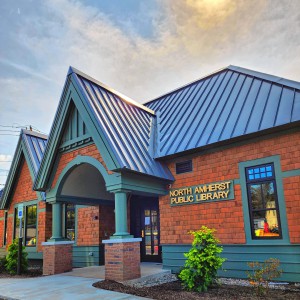Expanding the perspective: Porter-Phelps property in Hadley wins designation as larger National Historic District
| Published: 08-04-2023 9:03 AM |
In 1973, the Porter-Phelps-Huntington house in Hadley, which dates to 1752, won designation on the National Register of Historic Places, the federal program that supports and coordinates efforts to protect the nation’s historic and archeological resources.
Now, half a century later, the historic house has become part of a much larger property that’s also been named a National Historic District under the purview of the National Park Service, a designation that in turn recognizes a broader history of the area.
The “Forty Acres and Its Skirts” District encompasses 114 acres and over 20 historic buildings along River Road in Hadley. Much of the landscape is made up of working farmland that’s been under cultivation for centuries, as well as a forested section that’s part of the Kestrel Land Trust.
And all that land tells a story, local historians say, that’s now been more extensively examined, bringing to the fore the lives of many people who once worked or lived there and are underrepresented in the historical record: enslaved people, indentured servants, Native Americans, free Black citizens, Polish laborers.
“For a long time, the focus here was on the house and this kind of romanticized version of Colonial history,” said Brian Whetstone, a public historian who earned his Ph.D. from the University of Massachusetts Amherst.
“But there’s a much broader story to tell,” said Whetstone, who was a key part of the research team that did the legwork to win designation for the new historical district.
He’ll give a talk at the museum this Sunday, Aug. 6, at 1:30 p.m. on that research and then lead a tour of the surrounding property.
During a recent interview at the museum, Whetstone noted that the new historic district designation will make it easier for the property to apply for and receive grants for additional research and renovations.
Article continues after...
Yesterday's Most Read Articles
 A Waterfront revival: Two years after buying closed tavern, Holyoke couple set to open new event venue
A Waterfront revival: Two years after buying closed tavern, Holyoke couple set to open new event venue
 ‘We can just be who we are’: Thousands show support for LGBTQ community at Hampshire Pride
‘We can just be who we are’: Thousands show support for LGBTQ community at Hampshire Pride
 3-unit, 10-bed house in backyard called too much for Amherst historic district
3-unit, 10-bed house in backyard called too much for Amherst historic district
 ‘Home away from home’: North Amherst Library officially dedicated, as anonymous donor of $1.7M revealed
‘Home away from home’: North Amherst Library officially dedicated, as anonymous donor of $1.7M revealed
 UMass basketball: Matt Cross announces he’s transferring to SMU for final year of eligibility
UMass basketball: Matt Cross announces he’s transferring to SMU for final year of eligibility
 Retired superintendent to lead Hampshire Regional Schools on interim basis while search for permanent boss continues
Retired superintendent to lead Hampshire Regional Schools on interim basis while search for permanent boss continues
One project on the list is repairing the Phelps house, built in 1816 on the east side of River Drive, a few hundred yards southeast of the original Porter-Phelps house. It’s part of what’s long been known as the Phelps Farm, in the past an integral part of the Porter-Phelps agricultural operation; the house needs a new roof, among numerous other repairs, Whetstone notes.
The original Porter-Phelps-Huntington home, known initially as Forty Acres, was owned by six generations of the same extended family before being turned into a summer home for descendants in the early 20th century, and then a museum in the mid-20th century. At one point, the property extended to 600 acres.
And because it was owned by that extended family, the property has long been a treasure trove for historians, giving them access to many original letters, documents, and other archival material, providing a valuable window into 18th- and 19th-century life in the Valley.
The more recent research was funded by a National Park Service grant for underrepresented communities, which was awarded to the Massachusetts Historical Commission in 2020. The commission in turn hired Whetstone and Marla Miller, the former director of the UMass Public History program, to do the work.
“Marla has been such a huge part of this,” said Whetstone, who noted he had not previously known anything about the Porter-Phelps property. “She brought me on board, and I’m really grateful.”
Miller, who lives in Hadley, has written two books and other work on the lives of women in Colonial New England, especially in Hadley. Her most recent book, “Entangled Lives,” notes that, among other things, Indigenous women did domestic work at the Porter-Phelps property in the late 18th and early 19th century, well after white settlers had forced many Native Americans in the region from their ancestral lands.
The newest research at Porter-Phelps has also revealed that six enslaved African Americans worked on the property in the 18th century, before slavery was phased out in Massachusetts in the 1780s.
Yet connections to the slave trade remained. Another UMass Ph.D. student, Alison Russell, has studied how Charles Phelps — he became part of the family in 1770 when he married Elizabeth Porter, the daughter of the two founders of the home, Moses Porter and Elizabeth Pitkin Porter — made money in the early 19th century through trade in plantation products such as sugar and cotton.
Whetstone says Phelps “made a killing” in Caribbean sugar around 1808 because the U.S. had just imposed an embargo on many products, including sugar, shipped to Europe, and some of Phelps’ sugar reached the Netherlands after its price had skyrocketed.
“That’s one of the things we learned,” he said. “Our own area was still entangled with the Atlantic slave economy, even after slavery ended here.”
Whetstone, who is headed to Princeton University this fall to do post-doctoral work, says his research at Porter-Phelps has concentrated on the 20th century, when James Lincoln Huntington, a family descendant and Boston obstetrician, began repairing the aging home and then turned it into a museum in 1949.
“He created touches that put the focus on the original house and its architecture and this kind of genteel image of life, rather than emphasizing that the whole property had been a working agricultural landscape,” Whetstone said.
For instance, Huntington took down some older buildings — one barn was moved to town center to become the Hadley Farm Museum — and placed an old millstone and other implements outside the house as decorative items. He also built the sunken garden where acoustic music concerts have been held since the early 1980s.
Looking through Huntington’s journals and diaries, Whetstone discovered Huntington relied on numerous Polish laborers for renovating and modifying the property, hiring people from families that had immigrated to Hadley and surrounding towns in the early 20th century.
Researchers also discovered a cache of financial records in the attic of Phelps Farm that have helped shed light on its status as an important dairying operation in Hadley in the 20th century, notably under the management of Doheny Hackett Sessions (1905–1994) and her family. The herd was sold in 1978, and Sessions became the museum director of Porter-Phelps-Huntington.
Agriculture, with its attendant risks, is still practiced here. Parts of Forty Acres and Its Skirts are rented to area farmers, and some of the tenants, including Stone Soup Farm in Hadley and New Community Farm Cooperative, lost significant amounts of crops from flooding in July.
That recent history could eventually become part of the overall narrative at the property. Whetstone and Susan Lisk, executive director of the Porter-Phelps-Huntington Foundation, say a key goal in what they’re trying to do here is called “Pastkeeping.”
That term, as Whetstone and Miller defined it on the application they wrote to the National Park Service on the property, means “the wide-ranging and ever-changing activities through which ‘people convey their understanding of the past’ and ‘give shape to time and its passage.’”
Or as Lisk says, “We want to tell as complete a story as possible about this land, the people who have lived and worked here, with special attention to those stories that haven’t been part of the narrative until now.”
Steve Pfarrer can be reached at spfarrer@gazettenet.com.

 Valley Bounty: Grass-fed animals that feed the grass: Gwydyr Farm in Southampton focuses on ‘restoring the connection between land, food and people’
Valley Bounty: Grass-fed animals that feed the grass: Gwydyr Farm in Southampton focuses on ‘restoring the connection between land, food and people’ Weekly Food Photo Contest: This week’s winner: Mary Chicoine of Easthampton
Weekly Food Photo Contest: This week’s winner: Mary Chicoine of Easthampton  Speaking of Nature: A romantic evening for two birders — To hear the wonderful sounds of the Saw-whet Owl one must go outside at night
Speaking of Nature: A romantic evening for two birders — To hear the wonderful sounds of the Saw-whet Owl one must go outside at night Speaking of Nature: Where have all the birds gone?: They’re there, and here’s a handy tool to keep track of their appearances
Speaking of Nature: Where have all the birds gone?: They’re there, and here’s a handy tool to keep track of their appearances
